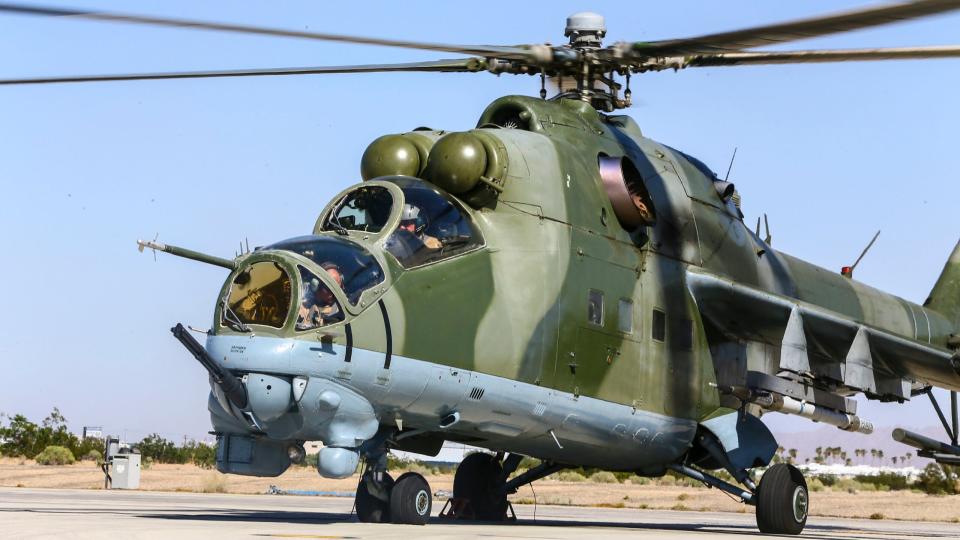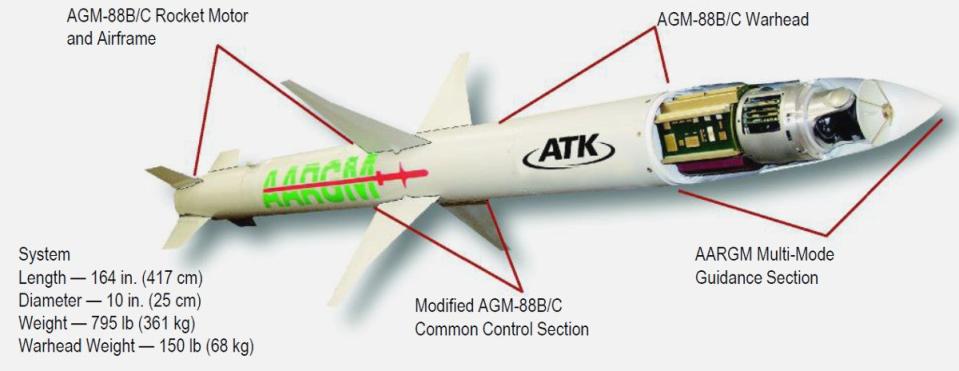EA-18G Growler Killed A Houthi Mi-24 Hind With An AGM-88E Anti-Radiation Missile

The Navy on Thursday confirmed to The War Zone that one of its EA-18G Growler electronic warfare aircraft used an AGM-88E Advanced Anti-Radiation Guided Missile (AARGM) to destroy a Mi-24/35 Hind attack helicopter. This confirms a possible explanation we suggested when a mysterious “kill mark” of a Hind appeared on a Growler deployed aboard the aircraft carrier Dwight D. Eisenhower (Ike) in a photo that was released on May 15. The engagement also likely highlights the AARGM's unique precision strike capabilities against non-radiating targets.
"The first instance of AARGM use in combat was from an E/A-18G deployed on Ike, during this current deployment to the U.S. 5th Fleet region," a Navy official told us. The official could not say if that engagement was the same as the one that earned a Growler its Hind kill mark.
We initially posited that the kill likely involved an AARGM.
“The Hind was reportedly struck on the ground, which is strange for a Growler,” The War Zone's Tyler Rogoway tweeted on May 16. “Best guess: they fired AARGM to hit coordinates, not home in on emissions, which it's capable of. It is a good time-sensitive target effector in this way. We'll find out more.”
That's pretty much what happened on Feb. 24, the Navy official told The War Zone.
“The Dwight D. Eisenhower (Ike) Carrier Strike Group led pre-planned self-defense strikes into Houthi-controlled territories in Yemen,” the official told us. “This was a joint and coalition effort that struck 60 Houthi targets across 16 sites in Yemen, including anti-ship missile sites, storage facilities and command and control centers. Also destroyed was a rotary-wing aircraft; the aircraft was unmanned and not airborne at the time.”

The Growler, from VAQ-130 “Zappers,” conducted "an air-to-surface engagement with an AGM-88E Advanced Anti-Radiation Guided Missile (AARGM) on a ground target that destroyed a rotary-wing aircraft,” the official added. “It is suspected that the helicopter belonged to Iranian-backed Houthi terrorists in Yemen, who have menaced civilian merchant shipping, taken innocent lives, and put feeedom of navigation at risk.”
CENTCOM posted a launch video from that operation, which you can see below.
The AARGM, which is a direct evolution of the AGM-88 High-Speed Anti-Radiation Missile (HARM), is designed primarily to suppress and destroy enemy air defenses. It can reach targets more than 80 miles away and reach speeds of well over twice the speed of sound. The AGM-88E was first test-fired from Growlers in 2011, according to the Navy, and has been in service for a number of years.
“AARGM has demonstrated a much greater accuracy than our existing HARM inventory in striking hostile emitters,” Cmdr. Chad Reed, then-deputy program manager for Anti-Radiation Missiles within the Direct and Time Sensitive Strike program office (PMA-242), said at the time. “The weapon is specifically designed to increase our warfighting capabilities in neutralizing enemy air defenses and will provide aircrews with an additional tool for the electronic attack mission.”

The AARGM is different from its progenitor, the HARM, in a number of ways. Chief among them is that it can hit a threat radar with high-precision even if it stops emitting radiation. This means that if a radar shuts off mid-attack, the AARGM will still strike it and do so with extreme accuracy. The addition of an active millimeter-wave radar seeker even allows the AARGM to hit its target if it is fleeing from its original position.
This standoff precision strike capability also allows the AARGM to be used in a secondary capacity as a rapid response strike weapon against non-air defense-related targets. In other words, it can be used to quickly strike a non-radiation emitting target on the ground over long distances. In this case, something in the Navy's 'kill chain' or pre-mission intelligence spotted the Mi-24 and the AARGM was used to destroy it as it sat on the ground, using GPS/INS to make its way to the target, then homing in on it using its millimeter-wave radar seeker. Otherwise, it was destroyed via collateral damage caused by another target that was hit nearby, although that seems less likely of an explanation.
https://www.youtube.com/watch?v=FCBs1IEk9Fc\u0026t=1s
The Growler kill mark was the latest in a long tradition of such art being stenciled onto aircraft, vessels and other military equipment indicating the destruction of enemy equipment. In March, for instance, we wrote about the U.S. Navy's F/A-18E/F Super Hornets deployed aboard the Ike were adorned to commemorate the downing of Houthi drones. They have also appeared on allied aircraft involved in these missions. That followed kill marks seen on warships that swatted down similar threats in the region.
This kill, as we previously noted, also comes as the Growlers are getting expanded air-to-air missile capabilities via additional AIM-120 AMRAAM carriage options, with the AIM-9X being added soon, as well. Considering the activity of Houthi drones over and around the Red Sea, it's possible that a Growler could score its first air-to-air kill at any time, if one hasn't already.
The Yemeni Air Force had a number of Mi-24/35 Hind derivatives before the war with the Saudi-led Arab coalition broke out against Houthi rebels in the western part of the country. It was originally thought that any in their possession were destroyed or left totally unserviceable during the conflict, while other reports suggested a small number of them saw action in recent years.
Regardless of the disposition of the fleet, there is now one less Hind in Houthi hands.
Contact the author: howard@thewarzone.com

